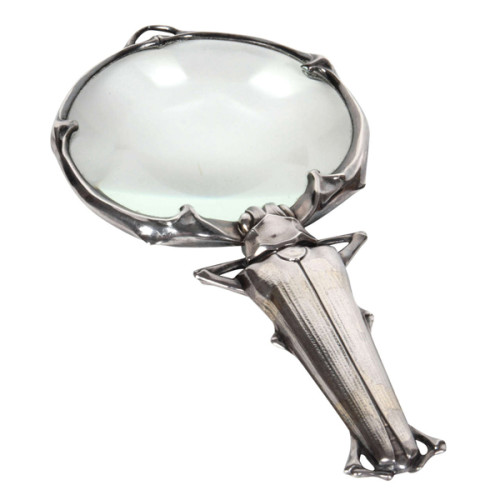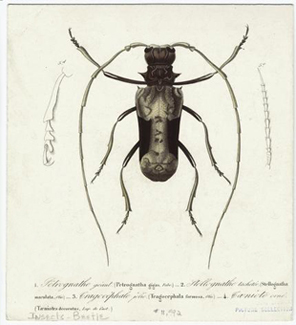Product Description
Important Lucien Gaillard “Staghorn beetle” silver and gold inlay magnifying glass, signed c. 1900



Silver hand finished and repoussed in the form of a staghorn beetle with horns encircling the round magnifying glass, gold details
Signed: L. GAILLARD (engraved) on lower right leg, head of Minerva (950/1000 pure silver)
The staghorn beetle was a favorite form for Gaillard and the inspiration for many examples of his work including jewelry, vases and this magnifying glass. A variant model in cast bronze can be seen in the collection of the Musee d’Orsay in Paris.
Important Lucien Gaillard “Staghorn beetle” silver and gold inlay magnifying glass, signed c. 1900
CHARLES CATTEAU (1880-1966)
BOCH FRERES KERAMIS La Louviere Belgium
Tulip vase c. 1930
Glazed earthenware
Marks: “Keramis” Made in Belgium , D. 2524 B, 945
H: 10 1/4″ x D: 6 1/2″
Charles Catteau could be regarded as one of the most versatile ceramic artists of his generation, especially for the style of Art Deco. Catteau advanced the forms, techniques and decoration of modern ceramics, creating an exceptionally original, new and decorative genre.
Hired as a ceramic decorator in Ecole Nationale de Sèvres from 1903 to 1904, he began producing designs that were rather traditional, based on the observation of nature, and showing the influence of Japonisme, characterized by pure lines and meticulous details. From 1904 to 1906, he worked in Nymphenburg Porzellan Manufaktur near Munich, a factory specializing in new hand painting procedures under a slip, as well as Art Nouveau.
In 1907 he finally moved to Louvière in Belgium where he was promoted to head of the decoration department at Boch Freres Keramis at the age of 27. This is where most of his exceptional talent came to the fore especially during the period between the two World Wars. Influenced by the great creative art movements of the time (Africanism, Japonisme, Cubism, Abstraction) and his observation of nature gave him inspiration for his designs, with the integration of plants, stylized animals and geometric motifs. The international avant-garde movements were also an influence leading to his use of purely abstract, geometric designs and intense colors. Charles Catteau was incredibly resourceful and explored various harmonies of form, techniques, designs, colors, shades, topics, variants and influences. In this way Catteau became a representative par excellence of Art Deco designs, giving it his personal touch. He was instrumental in introducing technical innovations during the 20’s and 30’s to aid mass production of ceramic products and expand availability of affordable products. During difficult times in Europe, he created vivid, colorful, original and uplifting ceramic wares.
Charles Cotteau motto was “Art for All” and he also taught decorative painting at the School of Industrial in Louvière. In 1925 he obtained international recognition in the exhibition of Decorative Arts in Paris. which helped raise the profile of Boch Freres. He remained at the company until he retired to Nice in 1946 .
The well known Beverly Hills jeweler, William Ruser, started his career at the firm of Trabert & Hoeffer-Mauboussin in Atlantic City New Jersey, before being transferred to manage their Los Angeles location in the 1930’s. In 1947, he and his wife opened their eponymous boutique on Rodeo drive. While keeping traditional diamond and precious gemstone merchandise in stock, the Rusers’ specialty was baroque, freshwater pearl jewelry. In the 1930’s, Ruser had bought several shoeboxes full of these oddly shaped, American pearls from a button manufacturer. Freshwater pearls had been relatively unpopular at the time. Though Art Nouveau jewelers used them liberally to embellish their pieces, jewelers in the 1920 and 30’s did not follow suit. In the late 1940’s and throughout the 1950’s, Ruser helped to change this. In the vanguard, along with Verdura and Seaman Schepps, the Rusers created swans, hummingbirds, poodles, skunks, as well as playful cherubs with freshwater pearl accents. Throughout the 1950’s and 60’s, business boomed and Hollywood starlets proudly wore his figural pieces both on and off screen. In 1969, Ruser closed up shop, selling its location to Van Cleef & Arpels.
